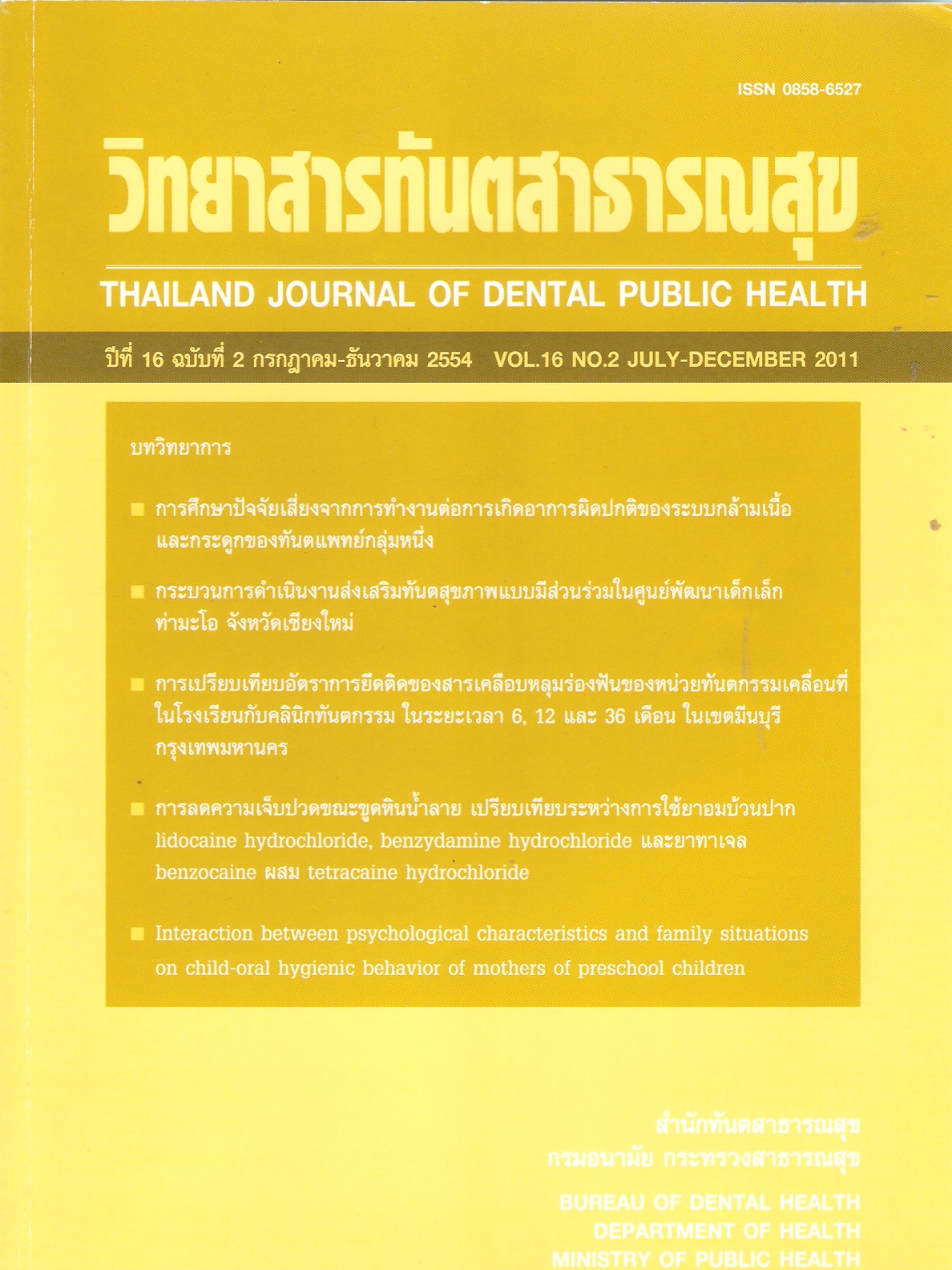การศึกษาปัจจัยเสี่ยงจากการทำงาน ต่อการเกิดอาการผิดปกติของระบบกล้ามเนื้อ และกระดูกของทันตแพทย์กลุ่มหนึ่ง
Main Article Content
บทคัดย่อ
งานวิจัยนี้มีวัตถุประสงค์เพื่อศึกษาปัจจัยจากการทำงานที่เสี่ยงให้เกิดอาการผิดปกติของระบบกล้ามเนื้อและกระดูกสำหรับทันตแพทย์ โดยมีประชากรเป้าหมายเป็นทันตแพทย์ไทย ในเขตกรุงเทพมหานคร จำนวน 360 คน สุ่มเลือกจากการลงทะเบียนประวัติของทันตแพทยสมาคมแห่งประเทศไทยฯ โดยวิธีสุ่มอย่างง่าย ออกแบบการศึกษาเป็นการวิจัยเชิงสำรวจภาคตัดขวาง เก็บรวบรวมข้อมูลทางไปรษณีย์ โดยใช้แบบสอบถามเกี่ยวกับปัจจัยในการทำงาน และอาการผิดปกติของระบบกล้ามเนื้อและกระดูก ผลการศึกษาอาการผิดปกติของระบบกล้ามเนื้อและกระดูกจากการทำงานในช่วงเวลา 12 เดือน ที่ผ่านมาพบว่าร้อยละ 69.7 มีอาการเจ็บปวดอย่างน้อย 1 ตำแหน่ง ส่วนใหญ่ร้อยละ 71.1 มีอาการที่ไหล่ รองลงมาร้อยละ 60.8 มีอาการที่คอ 49.7 มีอาการที่บริเวณหลังส่วนบน และร้อยละ 46.7 มีอาการที่ข้อมือหรือมือถือ ปัจจัยส่วนบุคคล จากผลการศึกษาพบว่า ปัจจัยเพศ อายุ และอายุการทำงานมีความสัมพันธ์กับการเกิดความผิดปกติระบบกล้ามเนื้อและกระดูก ปัจจัยการทำงานที่ส่งผลให้เกิดอาการผิดปกติของระบบกล้ามเนื้อ และกระดูกประกอบด้วยชั่วโมงการทำงานต่อสัปดาห์ ช่วงเวลาพักระหว่างการทำงาน ความถนัดของมือที่ทำงาน การใช้เครื่องมือที่มีการสั่นสะเทือน ตำแหน่งที่นั่งทำงาน ท่านั่งทำงาน การใช้ท่าทางซ้ำๆ ในกานทำงาน เวลาการใช้งานคอมพิวเตอร์ และระดับความเครียด โดยปัจจัยจากการทำงานเหล่านี้ พบมีความสัมพันธ์กับการเกิดอาการผิดปกติของระบบกล้ามเนื้อและกระดูกอย่างมีนัยสำคัญทางสถิติ (p ≤ 0.05) นอกจากนี้ ยังพบว่าพฤติกรรมสุขภาพด้านการออกกำลังกาย ได้แก่ ความถี่ของการออกกำลังกายต่อสัปดาห์ และระยะเวลาที่ใช้ในการออกกำลังกายต่อครั้ง มีความสัมพันธ์กับอัตราการเกิดอาการผิดปกติของระบบกล้ามเนื้อและกระดูกจากการทำงานในช่วงเวลา 1 ปีที่ผ่านมา อย่างมีนัยสำคัญทางสถิติ (p ≤ 0.01)
Downloads
Article Details
References
2. Valachi B. and Valachi K. Mechanisms leading to musculoskeletal disorders in dentistry. American Dental Association 2003; 134:134-1350.
3. Rada RE. and Johnson-Leong C. Stress, burnout, anxiety and depression among dentists. Practice Management JADA, 2004; 135:788-794.
4. Puriene A., Aleksejuniene J., Petrauskiene J., Balciuniene I. and Janulyte V. Self-reported Occupational Health Issues among LithuanianDentists. Industrial Health 2008;46:369-374.
5. Alexopoulos EC., Stathi IC. and Charizani F. Prevalence of musculoskeletal disorders in dentists. BMC Musculoskeletal Disorders 2004; 5:1-8.
6. Leggat PA. and Smith DR. Musculoskeletal disorders self reported by dentists in Queensland, Australia. Australian Dental Journal2006, 51(4):324-327.
7. Chowanadisai S., Kukiattrakoon B.,Yapong B., Kedjarune U. and Leggat PA. Occupational health problems of dentists in southern Thailand. Int Dent J, 2000; 50(1):36-40.
8. แมนสรวง วงศ์อภัย. ภาวะสุขภาพจากการ ทำงานของทันตแพทย์ภาครัฐ จังหวัด เชียงใหม่, การค้นคว้าแบบอิสระสาธารณสุขศาสตรมหาบัณฑิต บัณฑิตวิทยาลัย มหาวิทยาลัยเชียงใหม่, พ.ศ. 2551
9. Yamane T. 1967. Statistics: An introductory analysis. 2nd ed. New York : Harper and Row.
10. กัลยา วานิชย์บัญชา, การใช้ SPSS for Windows ในการวิเคราะห์ข้อมูล พิมพ์ ครั้งที่ 8 บริษัทธรรมสาร จำกัดกรุงเทพมหานคร, 2549. หน้า16.
11. Kuorinka I., Jonsson B., Kilbom A., Vinterberg H., Biering-Sorensen F., Andersson G. et al. Standardised Nordic questionnaires for the analysis of musculoskeletal symptoms. Appl Ergon 1987; 18(3): 233-237.
12. Yamalik N. Musculoskeletal disorders(MSDs) and dental practice Part 1. General information-terminology, aetiology, work-relatedness, magnitude of the problem, andprevention. Int Dent J 2006; 56:359-366.
13. Larsson B. Work related neckshoulder pain: a review on magnitude, risk factors, biochemical characteristics, clinical picture and preventive interventions. Best Practice & Research Clinical Rheumatology 2007; 21:447-463.
14. Barbe MF and Barr AE. Inflammation and the pathophysiology of work-related musculoskeletal disorders. Brain Behav Immun 2006; 20(5):423-429.
15. Visser JL. and Straker LM. Investigation of Discomfort Experienced by Dental Therapists and Assistants and Works. Aust Dent J 1994; 39:39-44.
16. Kihara T. Dental care works and work-related complaints of dentists.Kurume Medical Journal. 1995; 42(4):251-257
17. Green EJ. and Brown ME. An aid to the elimination of tension and fatigue: Body mechanics applied to the practice of dentistry. J Am Dent Assoc 1963; 67: 679-97
18. Reitemeier B. Psychophysiological and epidemiological investigations on the dentist. Reviews on Environmental Health 1996; 11:57-63
19. Rundcrantz BL., Johnsson B. and Moritz U. Occupational cervicobrachial disorders among dentists-analysis of ergonomics and locomotor functions. Swedish Dental Journal 1991; 15:105-115.
20. Davies MH. and Eccles JD. Attitudes of dental patients to conservation treatment in different chair positions. Journal of Dentistry 1978; 6:294.
21. Rundcrantz BL., Johnsson B. and Moritz U. Cervical pain and discomfort among dentists. Swedish Dental Journal 1990; 14:71-80.
22. NIOSH [Second Printing, 1997.] Musculoskeletal Disorders and Workplace Factors: A Critical Review of Epidemiologic Evidence for Related Musculoskeletal Disorders of the Neck, Upper Extremity, and Low Back. Cincinnati, OH: US Department of Health and Human Services, Public Health Service, Centers for Disease Control and Prevention, National Institute for Occupational Safety and Health. DHHS (NIOSH) Publication No. 97-141.
23. Kroemer KHF. Cumulative trauma disorder their recognition and ergonomics measures to avoid them. Applied ergonomics 1989; 20(4): 274-280.
24. Akesson I., Lundborg G., Horstmann V. and Skerfving S. Neuropathy in female dental personnel exposed to high frequency vibrations. Occupational and Environmental Medicine 1995; 52:116-123.
25. Ariens GA. Psychosocial risk factors for neck pain: a systematic review. American Journal of Industrial Medicine 2001; 39(2):180-193.
26. Breakwell GM. Are you stressed out? American Journal of Nursing 1990, 9: 31-33.
27. Jeffrey Nk., Benjamin CA., Barbara BC., Christine H., Anne HF. and Christopher MC. Prevalence of Upper Extremity Musculoskeletal Disorders in College Students. The American Journal of Medicine 2000; 109:586-588.
28. Auguston TE. and Morken T. Musculoskeletal problems among dental health personnel. A survey of the public dental health services in Hordaland (Norwegien). Tidsskrift for Den Norske Laegeforening 1996;116:2776-2780
29. Shugars DA., Williams D., Cline SJ. and Fishburne C. Musculoskeletal back pain among dentists. General Dentistry 1984; 32:481-48

